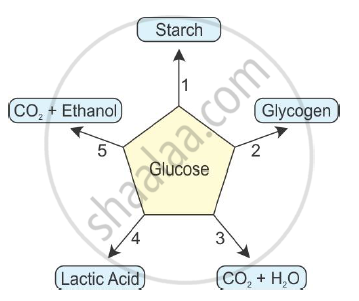Advertisements
Advertisements
Question
Explain how, the air we breathe in gets cleaned while passing through the nasal passage.
Solution
The nasal passage is lined with fine hair and mucus. When air passes through the nasal passage, the dust particles and other impurities present in it are trapped by the nasal hair and mucus. Due to this, only clean air reaches the lungs.
APPEARS IN
RELATED QUESTIONS
Given below are the end products of different reactions involving glucose.

Write the reaction number in front of the following:
(i) Anaerobic reaction =
(ii) Reaction in the human muscles =
(iii) Aerobic respiration =
(iv) Reaction in the plant cells =
(v) Reaction in the liver
The breakdown of pyruvate to give carbon dioxide, water, and energy takes place in ______.
Out of photosynthesis and respiration in plants, which process occurs:
(a) all the time?
(b) only at daytime?
Explain why, it is dangerous to inhale air containing carbon monoxide.
Internal respiration may be defined as:
There is a pair of bean-shaped organs P in the human body towards the back, just above the waist. A waste product Q formed by the decomposition of unused proteins in the liver is brought into organ P through blood by an artery R. The numerous tiny filters S present in organ P clean the dirty blood by removing the waste product Q. The clean blood goes into circulation through a vein T. The waste substance Q, other waste salts, and excess water form a yellowish liquid U which goes from organ P into a bag-like structure V through two tubes W. This liquid is then thrown out of the body through a tube X.
(a) What is (i) organ P, and (ii) waste substance Q?
(b) Name (i) artery R, and (ii) vein T.
(c) What are tiny filters S known as?
(d) Name (i) liquid U (ii) structure V (iii) tubes W, and (iv) tube X.
Answer this question.
What are the holes on the sides of the body of insects called?
Answer the following in short.
Define respiration.
Given below is an example of certain structure and its special functional activity:
"Kidney and excretion".
Fill in the blanks on a similar pattern.
Epiglottis and _____________.
Given below is an example of certain structure and its special functional activity:
"Kidney and excretion".
Fill in the blanks on a similar pattern.
'C' shaped cartilage rings and ____________.
Given below is an overall chemical reaction of a certain process:
C6H12O6→LacticAcid+2ATP+Heat energy
Is this reaction applicable to animals or to plants or to both animals and plants?
With regard to the respiratory system and the process of respiration in man, answer the following question:
What is meant by :
- Residual air and
- Dead air space
Draw a diagram of the human respiratory system and label - pharynx, trachea, lungs, diaphragm and alveolar sac on it.
Why is respiration essential for life?
____________ is the maximum amount of air that the lungs can hold after a maximum forceful inspiration.
How much percent of C02 is transported in a dissolved form as carbonic acid?
What is common between extensive network of blood vessels around walls of alveoli and in glomerulus of nephron?
During respiration exchange of gases take place in
During the process of exhalation, the ribs move
Visit a doctor. Find out about artificial respiration. Ask the doctor:
- When does a person need artificial respiration?
- Does the person need to be kept on artificial respiration temporarily or permanently?
- From where can the person get supply of oxygen for artificial respiration?
